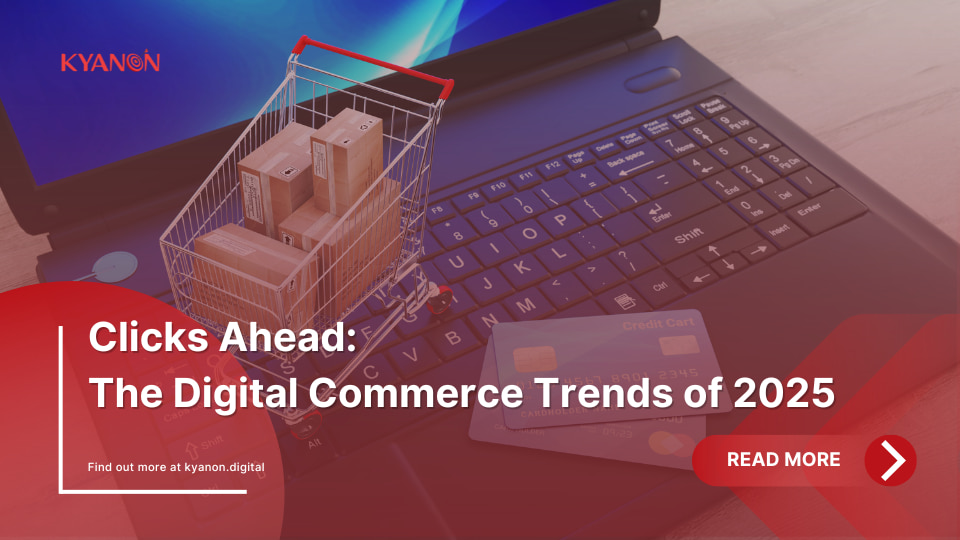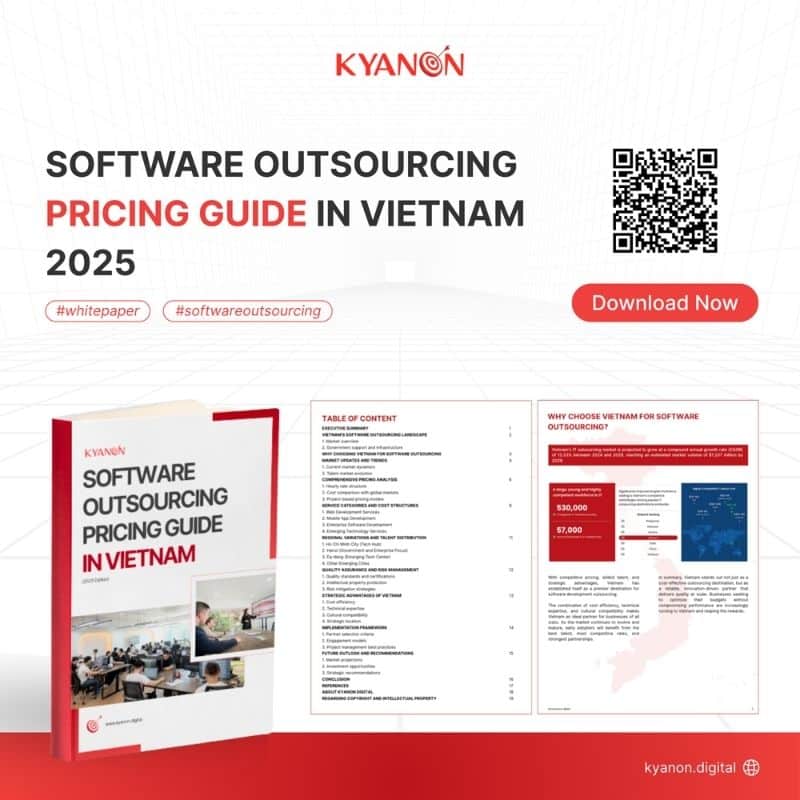The Dynamic World of Digital Commerce in 2025
Digital commerce trends are changing the way businesses work, making technology more important than ever. By 2025, global e-commerce sales are expected to go to about $6,8 trillion, showing just how much the market is growing. Transaction value in the digital commerce market is projected to reach US$7.53 trillion in 2025. Businesses need to stay updated to keep up with these changes. (Statista)

Retail e-commerce sales worldwide from 2014 to 2027 (in billion U.S. dollars). Source: Statista
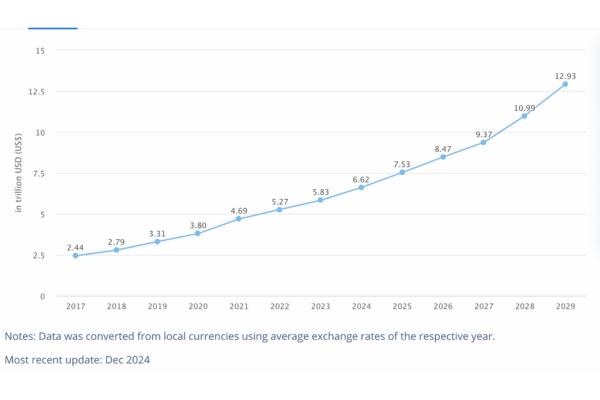
The transaction value of the digital commerce market. Source: Statista
New trends in ecommerce are shaping the way people shop online. Customers now expect faster, smoother, and more personal experiences. Technologies like AI, blockchain, and tools that connect online and offline shopping are becoming essential.
At the same time, exciting innovations like virtual reality shopping and voice commerce are transforming the future of online shopping. These tools allow businesses to connect with customers in new and interactive ways.
For businesses, adapting to these changes isn’t just a choice—it’s a necessity. The trends shaping 2025 will provide fresh opportunities to grow and compete in a fast-changing digital world. Let’s explore how these trends will impact the future of digital commerce.
Further reading:
Why Hyper Personalization Outshines Old Methods?
What Is Digital Commerce & How It Works
AI Adoption in Business: Challenges and Opportunities
Trend 1. Hyper-Personalization Powered by Artificial Intelligence (AI)
Imagine a salesperson who works nonstop. They know your consumers’ tastes better than they do. They provide exactly what they want before they ask for it. In digital commerce, that is the enchantment of AI-driven hyperpersonalization.
Hyper-personalization will not be a trend in 2025; it will be essential for companies to stay competitive. AI technologies are transforming online shopping, personalizing every aspect to match each client’s preferences. These solutions boost engagement and conversions and provide unique, data-driven experiences, like those of digital service reps.
Why Hyper-Personalization Matters
- Enhanced Decision-Making
87% of B2B buyers report that personalized content helps them make better purchasing decisions. Customers increasingly expect brands to anticipate their needs, making personalization a key differentiator.
- Increased Customer Retention
Top retailers are using AI-powered personalization, and early trials have shown a 10% to 25% increase in return on ad spend for targeted campaigns (Bain & Company). By addressing individual preferences, brands build trust and long-term loyalty.
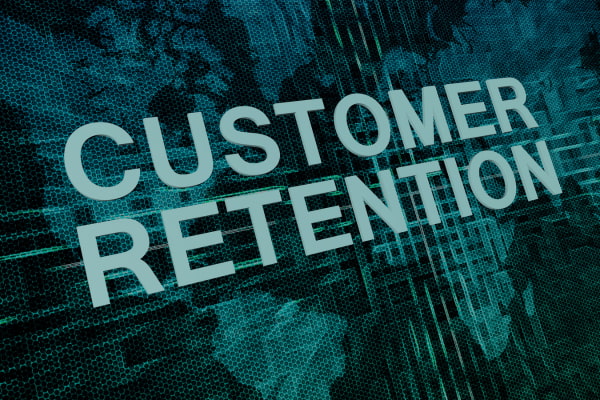
Adapting hyper-personalization can increase customer retention
- Higher Revenue Potential
Statistics show that sessions that contain no engagement with product recommendations have, on average, an AOV of $44.41. However, when prospects engage with just a single recommendation, this number multiplies by 369% (Big Commerce).
How AI Powers Hyper-Personalization
- Behavioral Analytics
AI analyzes purchase history, browsing habits, and interaction patterns to predict what customers are likely to buy. For example, Amazon uses machine learning to recommend products based on past searches, purchases, and even seasonal trends.
- Dynamic Content Delivery
AI customizes website layouts, email campaigns, and app interfaces in real time. Imagine landing on an e-commerce site that greets you with personalized discounts or product suggestions based on your last visit.
- Natural Language Processing (NLP)
AI-powered chatbots offer instant, personalized support. These virtual assistants, like Shopify’s Kit or Drift, engage customers conversationally, guiding them to the right products while resolving queries efficiently.
- Predictive Analytics for Inventory Management
By analyzing trends and consumer demand, AI helps businesses optimize inventory, reducing overstock and stockouts. This ensures customers always find what they’re looking for.
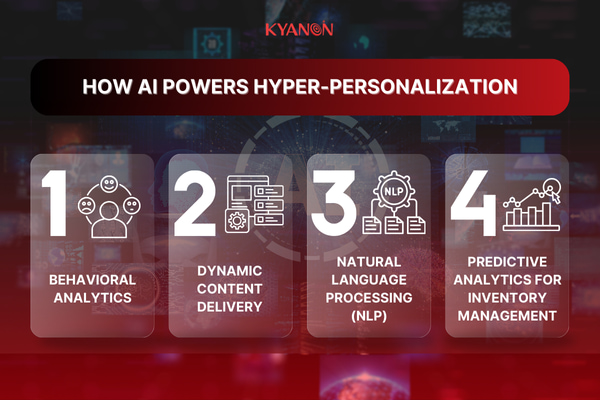
How AI powers hyper-personalization
Real-World Applications of AI Personalization
1. Salesforce Einstein: Automates personalized product recommendations and prioritizes leads for sales teams.

Salesforce Einstein (Source: Salesforce)
2. Netflix and Spotify: AI curates tailored playlists and recommendations, keeping users engaged and loyal.

Netflix and Spotify
3. Alibaba: Alibaba uses AI to deliver shopping suggestions during major events like Singles’ Day, ensuring a seamless customer journey.

Alibaba Group
How Businesses Can Adapt to AI-Driven Personalization
- Invest in AI-Powered Platforms: Platforms like Salesforce, HubSpot, and Adobe Sensei offer scalable solutions for businesses looking to implement personalization. These tools range from product recommendations to advanced customer segmentation.
- Leverage First-Party Data: With third-party cookies becoming less reliable, focus on collecting and analyzing first-party data through CRM systems, loyalty programs, and direct interactions.
- Optimize for Omnichannel: Synchronize personalization efforts across all touchpoints—websites, apps, emails, and even physical stores—to create a seamless customer experience.
- Start small, scale strategically: Begin by integrating AI in high-impact areas like product recommendations or dynamic pricing. Gradually expand to include chatbots, predictive analytics, and personalized marketing campaigns.
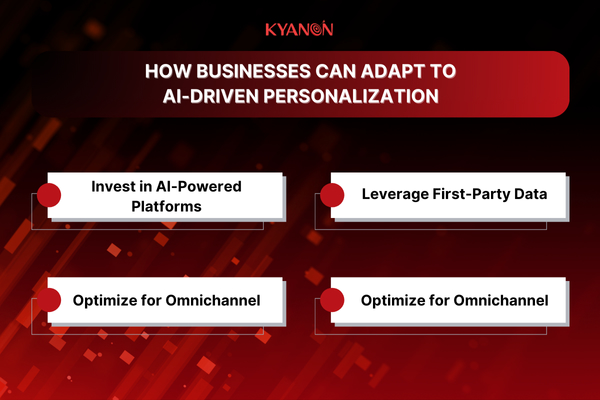
How Businesses Can Adapt to AI-Driven Personalization
Transform your ideas into reality with our services. Get started today!
Our team will contact you within 24 hours.
Trend 2: Seamless Omnichannel Commerce Strategies
One of the most significant shifts in digital commerce trends is the blending of physical and digital channels to create seamless, consistent customer experiences. This shift has been driven by the changing expectations of modern consumers who want the flexibility to shop and interact with brands across multiple platforms without compromising on service quality or convenience.
New trends in ecommerce highlight that businesses that effectively integrate both online and offline touchpoints are more likely to build stronger customer relationships and drive higher sales. Trends in online shopping show that customers are increasingly expecting a fluid experience that moves effortlessly between mobile apps, websites, and in-store visits, reinforcing the need for seamless omnichannel strategies.
Seamless Omnichannel Commerce in Action: Real-world examples
Leading retailers are already setting the stage for this transformation. For example, Nike allows customers to make online purchases and then return items in-store, creating a convenient and cohesive shopping experience.
This approach enhances customer satisfaction by giving shoppers flexibility and convenience while maintaining the in-store brand experience.

Nike on App Store (Source: Nike)
Similarly, food delivery services are incorporating app-based loyalty programs that customers can use not just for online orders but also during in-person dining experiences.
This integration helps brands keep customers engaged across different channels, providing consistent value whether they’re ordering food online or enjoying a meal at a physical location.
1. Starbucks Rewards Program
Starbucks seamlessly integrates its app-based loyalty program across both online and in-store experiences. Customers can earn stars for purchases made through the app, whether they order ahead for pickup, have their coffee delivered, or make a purchase in-store.
This consistent rewards system keeps customers engaged across channels, encouraging repeat business and brand loyalty.
2. Domino’s Pizza Points
Domino’s offers its “Piece of the Pie Rewards” program through its app, where customers earn points for every order, regardless of whether it’s placed online or in-store.
These points can be redeemed for free menu items, ensuring customers receive consistent value across all touchpoints, whether they dine in or order delivery.
3. McDonald’s MyMcDonald’s Rewards
McDonald’s has created a unified loyalty experience through its app, allowing customers to earn points for in-app orders, drive-thru pickups, and in-person dining. This approach ensures that customers feel rewarded for their patronage, regardless of how they interact with the brand.
Such efforts demonstrate how businesses are embracing the digital transformation in retail, recognizing the importance of meeting customers where they are, both online and offline.
Synchronizing Inventory and Customer Data Across Channels
In the rapidly evolving world of digital commerce trends, ensuring consistency across all customer touchpoints is crucial. One of the e-commerce trends 2025 is the integration of tools that synchronize inventory and customer data across channels.
This approach eliminates the discrepancies often found in isolated systems and enhances the overall shopping experience.
1. Walmart’s Inventory Integration
Walmart has implemented an advanced omnichannel strategy by synchronizing its inventory across all sales channels. Customers can check real-time product availability online before heading to their nearest store.
Additionally, Walmart’s mobile app allows shoppers to locate specific items within the store, saving time and enhancing convenience. This seamless integration not only builds trust but also encourages repeat visits.
2. Order Pickup and Drive-Up Services
Target uses synchronized inventory data to support its “Order Pickup” and “Drive-Up” services. Shoppers can browse online, confirm stock availability at their local store, and complete their purchase for quick collection.
This strategy has proven highly effective, especially during peak shopping periods, ensuring smooth operations and satisfied customers.
Unified Customer Support Through Live Chat
Customers in the era of digital transformation in retail demand instant responses and personalized assistance. Implementing live chat tools across platforms provides a seamless support experience, bridging the gap between online and offline channels. Live chat systems, powered by new trends in ecommerce, can integrate AI-driven chatbots and human agents to handle inquiries efficiently.
Consider a customer browsing Sephora‘s online store. While shopping, they have questions about the ingredients in a skincare product or the estimated delivery date. With the live chat feature available on the site, they can instantly ask for clarification and receive real-time, personalized answers from a customer service agent or an AI-driven chatbot.

Sephora’s online store (Source: Sephora App Store)
The seamless experience eliminates the frustration of waiting for email responses or searching for information on their own.
Now imagine the same customer is shopping in a Sephora physical store. They are browsing for new products and scan a QR code displayed next to a product on a shelf. The QR code takes them directly to the store’s live chat feature, where they can ask questions about the product, inquire about availability, or even request personalized recommendations, just as they would online.
This integration between in-store and online support offers a consistent, unified experience, making the customer feel supported no matter where they are in their journey.
Trend 3: Sustainability as a Competitive Advantage
In the world of digital commerce trends, sustainability has become more than a differentiator—it’s an expectation. Modern consumers, particularly Millennials and Gen Z, demand that brands actively contribute to environmental preservation. This shift reflects broader trends in online shopping, where ethical consumption and eco-friendly practices are major drivers of purchasing decisions.
As climate change and environmental concerns take center stage, businesses that integrate sustainability into their operations are better positioned to thrive. From production and packaging to delivery and marketing, sustainability now influences every aspect of the digital transformation in retail.
The adoption of e-commerce trends 2025 is helping companies achieve their sustainability goals through innovative solutions like green logistics, energy-efficient warehouses, and eco-friendly product lines.
Real-Life Adaptations
1. Eco-Friendly Packaging
Patagonia is a frontrunner in sustainability, using 100% recycled and responsibly sourced materials in its packaging. By aligning with trends in online shopping, Patagonia reinforces its environmental commitment and resonates with conscious shoppers.
Additionally, the company has implemented strategies to decrease plastic usage, such as altering product folding methods, which can reduce plastic packaging per product by up to 50%. (EgsDive)
2. Green Delivery Solutions
IKEA has adopted electric vehicles (EVs) for last-mile deliveries in multiple cities worldwide, reducing carbon emissions. Additionally, the company offers carbon offset options for online shoppers, directly tying sustainability into its digital transformation in retail strategy.
IKEA’s product transport constituted 4.7% of its total carbon footprint during its last financial year, while customer travel and home deliveries accounted for 11.5%. (Global Fleet)
3. Sustainable Product Lines
H&M’s Conscious Collection features items made from recycled or sustainably sourced materials, meeting consumer demand for eco-friendly products. Highlighting this initiative across digital channels helps attract Gen Z shoppers, 63% of whom prefer buying from sustainable brands. (First Insight)
How Businesses Can Implement This Technology
1. Partner with Eco-Friendly Logistics Providers
Collaborate with green delivery companies like UPS’s Carbon Neutral Shipping Program or DHL’s GoGreen initiative. These partnerships help businesses implement online shopping trending, including efficient routing to reduce emissions.
For example, fashion brand ASOS has partnered with delivery services offering bicycle couriers and EVs in urban areas, reducing its environmental footprint.
2. Highlight Sustainability in Marketing
Use marketing campaigns to showcase sustainability efforts, from eco-friendly packaging to carbon-neutral delivery options. Brands like Allbirds leverage their environmental initiatives in advertisements and social media, connecting deeply with eco-conscious audiences.
Include certifications like FSC (Forest Stewardship Council) for packaging or CarbonNeutral® labels for delivery services to build trust and credibility.
3. Invest in Sustainable Supply Chains
Reducing waste and energy consumption throughout the supply chain not only lowers costs but also reinforces your commitment to sustainability. For example, Unilever has made significant strides in using renewable energy in its manufacturing processes.
Unilever has invested in green technology projects, including installing solar power systems and using biofuels. In the supply chain, biomass fuel recycled from wood scraps, damaged pallets, and rice husks has replaced fossil fuels in boilers, cutting CO2 emissions by nearly 10,000 tons annually since 2007. (VietnamNews)
Trend 4: Immersive Commerce via AR/VR Technology
Augmented Reality (AR) and Virtual Reality (VR) are revolutionizing the future of online shopping by enabling virtual try-ons, immersive product demonstrations, and virtual storefronts.
- The proliferation of AR-capable devices is facilitating these advancements, with an estimated 1.03 billion mobile AR users worldwide in 2024, projected to reach 1.19 billion by 2028. (Statista)
- The global AR and VR market was valued at approximately $59.81 billion in 2024 and is expected to grow to $75.18 billion in 2025. (Precedence Research)
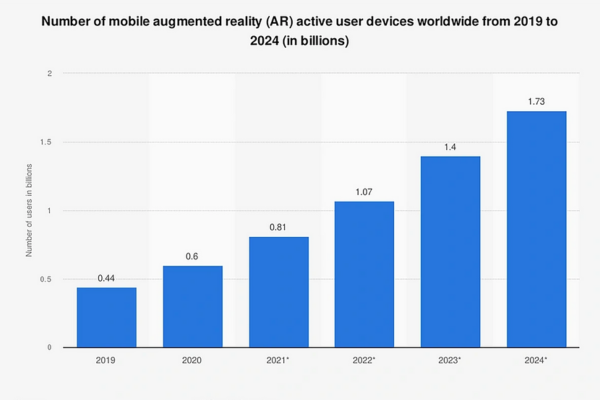
The number of AR devices across the world continues to climb. Source: Semrush
- Shipments of AR and VR headsets are projected to grow by 41.4% in 2025, driven by more affordable devices and the integration of artificial intelligence features. (Reuters)
Real-Life Examples
1. IKEA Place App
IKEA’s “Place” app leverages augmented reality (AR) technology to allow users to visualize how furniture would look in their homes before making a purchase. This immersive experience enhances the digital commerce trends by enabling customers to make more informed decisions.
- As of August 2023, the IKEA mobile shopping app was downloaded almost two million times globally from both the Google Play and Apple App Store. (Statista)
- The app has been downloaded 31.3 million times to date, with an average rating of 4.6 stars, indicating high user satisfaction. (Ingka Group)
- Since its launch in 2017, the IKEA Place app has contributed to a 35% increase in online sales and a 20% reduction in product returns, highlighting its effectiveness in enhancing the shopping experience.
2. Luxury Brand Virtual Runway Shows
Luxury fashion brands are increasingly hosting virtual runway shows, providing immersive experiences that showcase their collections to a global audience. This approach allows brands to reach a wider demographic and adapt to the growing demand for digital trends in online shopping.
- A significant portion of consumers believe that fashion weeks should transition to digital formats, indicating a shift in consumer preferences towards online fashion events. (Statista)
- The global immersive fashion market was valued at $1.9 billion in 2023 and is projected to grow to $9.9 billion by 2032, reflecting the increasing integration of digital experiences in the fashion industry. (Custom Market Insights)
Steps for Business Adoption
Here’s how businesses can adopt these cutting-edge tools to stay ahead of the Digital Commerce trends and create impactful, memorable interactions with their customers.
1. Develop AR-Powered Product Displays
Develop Interactive Product Catalogs: Instead of static images or videos, provide customers with the ability to interact with products in 3D, rotate them, change colors, and visualize how they fit in their environment. For instance, a clothing retailer can allow customers to “try on” clothes through AR before making a purchase.
Focus on Mobile-First Experiences: Since AR is best experienced on mobile devices, ensure your AR features are optimized for mobile users. The majority of e-commerce consumers browse and shop on their phones, so providing a seamless and engaging mobile AR experience will significantly enhance customer satisfaction and engagement.
Leverage AR for Personalization: Customize the AR experience to suit individual preferences. For example, if a customer has previously viewed a specific category of products (like shoes or accessories), the app could recommend related items and let them “try them on” virtually.
2. Explore VR for Immersive Brand Experiences
Create Virtual Tours or Experiences: For industries such as travel, real estate, or hospitality, VR can be used to offer virtual tours. Customers can “walk through” a vacation destination, tour an apartment, or experience an event before committing to a purchase or reservation.
Host Virtual Product Launches: Use VR for exclusive product launches or events, creating immersive experiences that allow customers to engage with the brand in a new and exciting way. These events could be streamed as VR experiences for global audiences, making the brand more accessible and dynamic.
Integrate VR with eCommerce: Use VR to allow customers to experience products in a simulated environment before purchasing. For example, furniture stores like IKEA use AR for product displays, while VR could be applied to simulate home decor setups in virtual spaces, helping customers make better purchasing decisions.
Trend 5: The Dominance of Mobile Commerce (M-Commerce)
As Digital Commerce trends evolve, one of the most significant shifts we’re witnessing is the dominance of mobile commerce (M-Commerce). Smartphones have become the primary shopping device for consumers, fundamentally changing the way brands and retailers approach their online sales strategies. In fact, the share of mobile commerce in all ecommerce has been on the rise, expected to reach 62% in 2027. (Big Commerce)
With consumers spending more time on their mobile devices, businesses are increasingly adopting mobile-first strategies to capture this growing audience. Mobile shopping is not just about making purchases on the go; it’s about creating seamless, convenient, and personalized experiences that cater to consumers’ preferences for speed, ease, and accessibility.
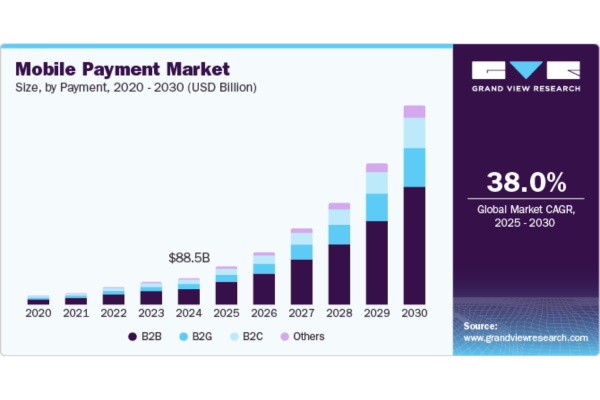
Mobile payment market (Source: Grand View Research)
Voice-Assisted Shopping
Voice search and voice-assisted shopping are gaining traction with consumers who prefer using virtual assistants like Siri or Alexa to make shopping decisions or place orders hands-free.
This voice-powered shopping experience is particularly popular for tasks like reordering frequently purchased items, adding to shopping carts, or searching for product recommendations.
Overall, many consumers are open to voice AI in shopping. The 2024 edition of PYMNTS Intelligence’s “How the World Does Digital” report, which drew from a survey of 67,000 consumers across 11 countries, revealed that 18% of the sample uses voice technology to shop at least once a week. Plus, 16% pay using the technology with the same frequency.
Adoption is particularly high among these younger generations. 30% of Gen Z consumers and 28% of millennials reported shopping via voice technology weekly, and 30% and 26%, respectively, pay. (PYMNTS)
One-Click Payment Solutions
Mobile wallets like Google Pay, Apple Pay and Amazon Pay further streamline the mobile purchasing process by simplifying payment verification. Additionally, social media apps have integrated click-to-buy buttons, allowing users to purchase directly from the app without switching platforms or devices.
According to Capital One research, 57% of e-commerce sales originate on mobile devices; this number is expected to reach 63% by 2028. In particular, if you want to build a brand that attracts Gen Z and millennials, you must prioritize mobile commerce.
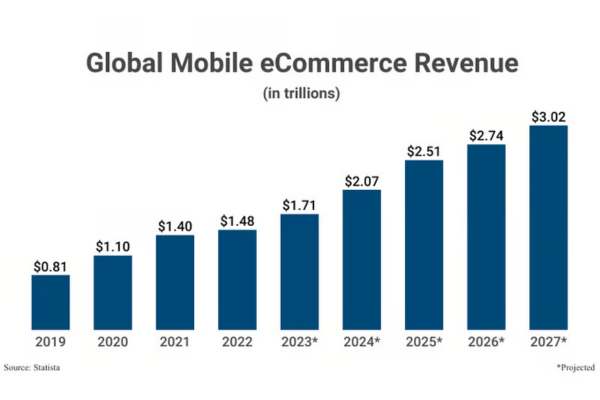
Global Mobile eCommerce Revenue (Source: Satista)
How Business Can Adapt
1. Optimize Websites for Mobile Responsiveness
Mobile optimization is no longer optional; it’s essential. Ensure that your website is fully responsive and provides an excellent user experience (UX) on smartphones and tablets.
Key elements like fast loading speeds, easy navigation, and mobile-friendly checkout processes are crucial in retaining customers and ensuring they don’t abandon their shopping journey.
2. Develop Progressive Web Apps (PWAs)
Progressive Web Apps (PWAs) offer a mobile-optimized experience that combines the best of both the web and native apps. PWAs load quickly, provide offline functionality, and give users an app-like experience without requiring a download from app stores.
By adopting PWAs, brands can deliver smoother, faster, and more engaging mobile experiences, which is essential for maintaining customer loyalty in the competitive mobile shopping landscape.
Challenges and Opportunities in Adopting Digital Commerce Trends
Adopting digital commerce trends presents both challenges and opportunities for businesses. As technology evolves, so do the expectations of consumers, forcing companies to keep up or risk falling behind.
However, businesses that successfully integrate new trends in ecommerce, such as voice-assisted shopping, one-click payment solutions, and mobile commerce, can unlock significant rewards.
Below, we explore some of the key challenges and opportunities businesses face as they adopt these commerce trends.
Challenges in adopting Digital Commerce trends
Technological Complexity: The integration of advanced technologies, such as AR/VR, AI-powered personalization, and mobile commerce solutions, requires significant investment in both time and resources. Businesses must navigate the complexities of these technologies, which often require specialized knowledge to implement effectively.
Data Privacy and Security Concerns: As businesses collect more customer data to personalize the shopping experience, the risks associated with data breaches and privacy concerns increase. With new regulations like GDPR in the EU and CCPA in California, businesses must ensure compliance while balancing personalized services with data protection.
Maintaining a Seamless Experience Across Channels: With the rise of omnichannel commerce, businesses must ensure a consistent and seamless customer experience across all touchpoints, whether online, on mobile devices, or in-store. Synchronizing inventory, customer data, and support tools across these channels requires sophisticated systems and platforms, which can be costly and complex to implement. Businesses that fail to integrate their channels may struggle with fragmented customer journeys and dissatisfaction.
Changing Consumer Expectations: Consumers now expect real-time, personalized, and frictionless shopping experiences. Meeting these expectations is challenging, especially when trying to offer hyper-personalization, one-click payment solutions, and fast delivery services on a mobile-first platform. Companies must continually adapt to new consumer behaviors and preferences, requiring constant innovation and agility.
Cost of Transition: Upgrading to the latest e-commerce technologies, implementing AI-driven personalization, or developing AR/VR capabilities can be costly, particularly for small or mid-sized businesses. Although the long-term benefits can be substantial, the initial investment in technology, talent, and training can pose a significant financial challenge.
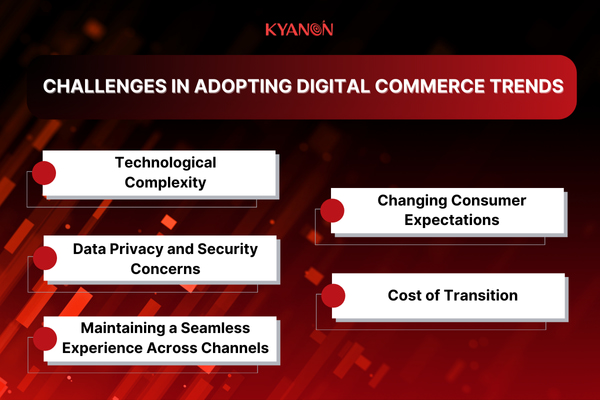
Challenges in adopting Digital Commerce trends
Opportunities in adapting Digital Commerce trends
Enhanced Customer Engagement and Loyalty: By adopting hyper-personalization and AI-driven recommendations, businesses can provide customers with tailored experiences that increase engagement and loyalty.
Expanded Market Reach: Mobile commerce is allowing businesses to reach customers globally, breaking down geographic barriers. Mobile-first strategies, combined with progressive web apps (PWAs), offer businesses the ability to deliver app-like experiences without requiring app downloads. As M-Commerce continues to grow, especially in emerging markets, businesses have an opportunity to tap into new, previously underserved customer segments.
Data-Driven Insights for Optimization: By leveraging customer data gathered across channels, businesses can optimize their offerings, tailor marketing campaigns, and streamline inventory management. With predictive analytics, brands can anticipate demand trends and adjust product availability in real-time, reducing stockouts and overstocking, leading to better resource allocation and higher profitability.
Immersive Shopping Experiences: The growth of AR/VR technologies is revolutionizing how consumers interact with products before purchasing. By offering virtual try-ons or immersive product demos, brands can provide a richer, more engaging shopping experience that enhances consumer confidence and boosts sales. Virtual stores and interactive product displays are especially appealing in industries like fashion, home goods, and beauty.
Optimizing Operational Efficiency: AI and automation can streamline various operational processes, from inventory management to customer support. Businesses that adopt these technologies can operate more efficiently, reducing costs and increasing productivity. Similarly, dynamic pricing powered by AI can adjust product prices in real-time to reflect market demand, increasing profitability.
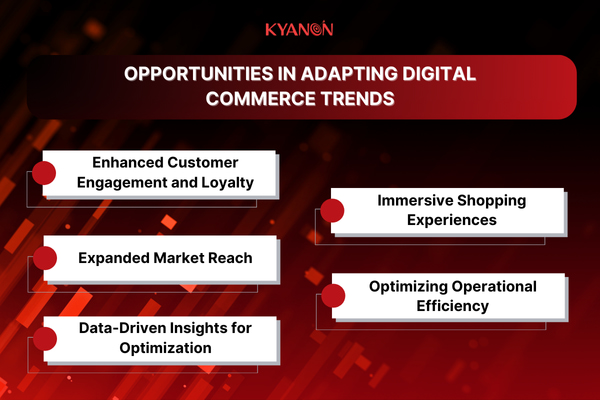
Opportunities in adapting Digital Commerce trends
Comparison of adapting Digital Commerce trends in the Asia-Pacific
|
Trend |
Market Size/Potential | Implementation Costs |
ROI Timeline |
|
Hyperpersonalization & AI |
$15.7B market size in APAC (2025) |
|
4-6 months |
|
Omnichannel Commerce |
$1.8T in APAC omnichannel retail sales |
|
6-12 months |
|
Sustainable E-commerce |
$2.5T green e-commerce market size |
|
12-18 months |
|
AR/VR Commerce |
$12.8B market size by 2025 |
|
12-24 months |
|
Mobile Commerce |
$3.2T in mobile transactions |
|
3-6 months |
Comparison of adapting digital commerce trends in the Asia-Pacific
Actionable Steps for Businesses to Stay Ahead in 2025
“The winning retailers will spend more time looking at the windshield and less time looking at the rearview mirror.” said Dunkin’ Brands
Tips for businesses to adapt to these e-commerce trends 2025:
- Invest in technology upgrades and employee training.
- Partner with tech providers offering solutions like AI, AR/VR, and omnichannel systems.
- Regularly assess market trends and customer expectations.
Conclusion: The Future of Digital Commerce Is Now
As digital commerce trends continue to evolve, embracing emerging technologies is crucial for businesses to stay competitive. The rise of mobile commerce, AI-driven personalization, AR/VR experiences, and sustainability initiatives offers tremendous opportunities for growth and differentiation.
Rather than viewing these trends in online shopping as challenges, businesses should see them as avenues to enhance customer experiences, optimize operations, and tap into new markets. By staying informed, adapting to new innovations, and continuously innovating, brands can position themselves as leaders in the future of online shopping.
The key to success lies in seizing these opportunities and leveraging them to create memorable, seamless, and sustainable shopping experiences for customers.
Ready to adapt those digital commerce trends to take your business to the next level? Kyanon Digital is here to help. Our experts specialize in accelerating digital transformation in retail solutions that deliver measurable results.
Contact Kyanon Digital today, and let’s create smarter, more effective digital commerce strategies that set your business apart!
Key Takeaways
- Embrace AI to drive hyperpersonalized experiences and predict customer needs.
- Implement omnichannel commerce strategies to meet customers wherever they shop.
- Prioritize sustainability initiatives to align with consumer values.
- Explore AR/VR technologies to stand out in an increasingly immersive digital landscape.
- Focus on mobile-first solutions to capture the majority of online shoppers.
References
Insights of Digital Commerce from:
- ICT Market Report 2025
- The Future of E-commerce: The Road to 2026 from Microsoft Word
- Global e-commerce trends report from McKinsey
- The Gift of Personalization: AI for Holiday Marketing Magic from Bain & Company
Statistics of the Digital Commerce markets from:
- Retail e-commerce sales worldwide from 2014 to 2027 are highlighted by Statista
- Digital Commerce – Worldwide from Statista
- 12 Ecommerce Trends That Are Powering Online Retail Forward from Big Commerce
- Augmented Reality and Virtual Reality Market Size and Forecast 2024 to 2034 from Grand View Research
- The State of Consumer Spending: Gen Z Shoppers Demand Sustainable Retail from First Insights

